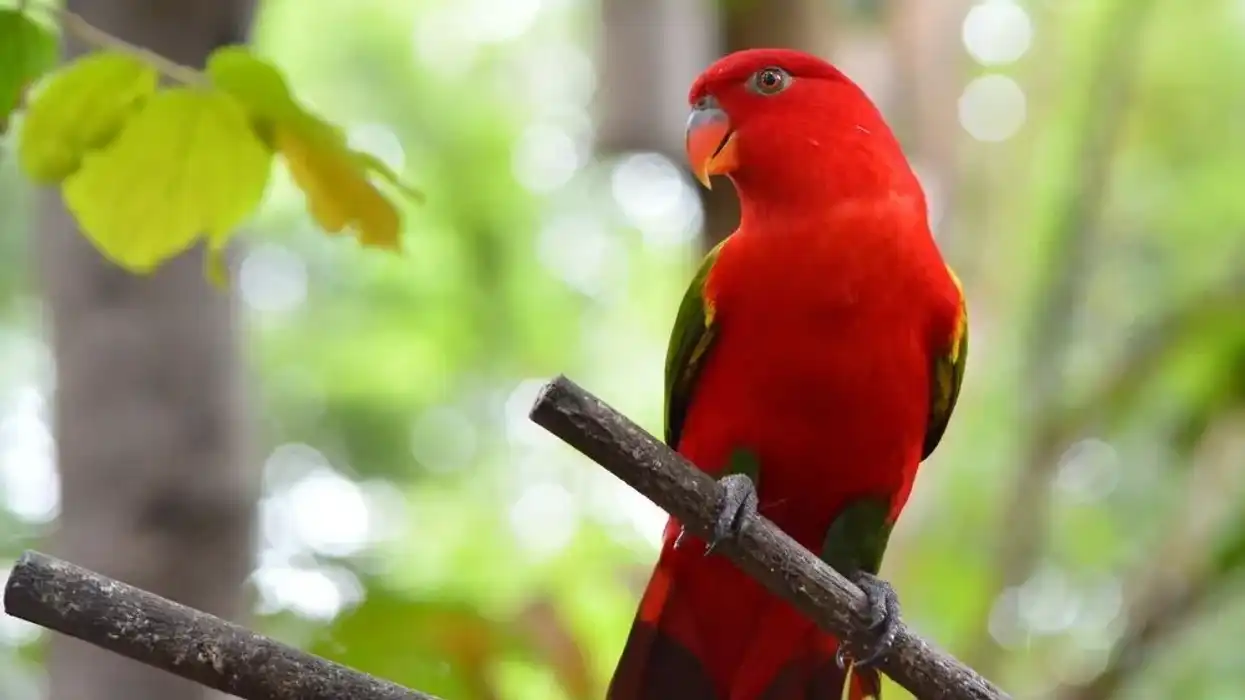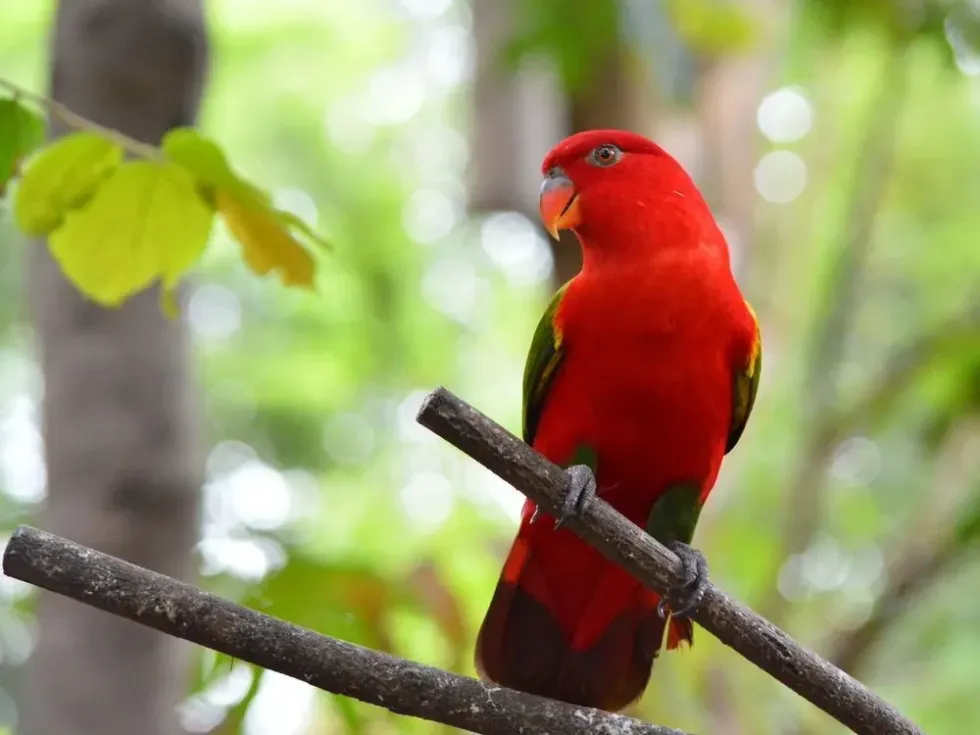Lories and lorikeets are small to medium-sized arboreal parrot species belonging to the Loriini tribe.
They are part of the Old World parrot family Psittaculidae and are characterized by unique brush-tipped tongues that let the birds easily soak up the nectar or collect pollen from flowers.
The majority of the bird species in this Loriini tribe have spectacular and brightly colored plumage, a thick, hooked beak, and overall physical features very similar to that of the parrots you usually see around.
These birds' geographical distribution is limited to the Australasian region, including Southeast Asia, Polynesia, Timor Leste, Papua New Guinea, and Australia.
Coming to the chattering lory (Lorius garrulus), the parrot species is endemic to the islands of North Maluku, Indonesia. It is a beautiful red parrot with green wings and thighs.
The tail is short, rounded, and dark green around the tip.
The chattering lory has three subspecies - Lorius garrulus flavopalliatus or the yellow-backed lory, Lorius garrulus morotaianus or the Morotai yellow-backed lory, and the nominate Lorius garrulus garrulus. Except for the nominate race, both the yellow-backed lories and the Morotai yellow-backed lories adults have a yellow patch on the mantle.
In their natural habitat, the birds are found in the canopy of lowland and hill forests and edges. However, the natural population of these loud, noisy, and chatty birds is on a decline since the species face threats from habitat loss and capturing for the cage bird trade.
Read on if you want to know more about the colorful and noisy chattering lories!
If you like what you read, do check out other interesting bird species such as the dusky lory and brown booby.
Chattering Lory Interesting Facts
What type of animal is a chattering lory?
The chattering lory (Lorius garrulus) is a species of parrot of the Old Worl parrot family Psittaculidae. It has three subspecies - L. g. flavopalliatus (yellow-backed lory), L. g. morotaianus (Morotai yellow-backed lory), and the nominate L. g. garrulus.
What class of animal does a chattering lory belong to?
Chattering lories belong to the class of birds.
How many chattering lories are there in the world?
An estimate of the present wild population size of the chattering lory is not available.
Where does a chattering lory live?
The chattering lory parrot is endemic to North Maluku, Indonesia. The yellow-backed lory is found on the Kasiruta, Obilatu, Obi, and Bacan Islands and the Morotai yellow-backed lory occupies the Morotai and Rau Islands in North Moluccas. The nominate race birds are found on the Halmahera, Ternate, and Widi Islands.
What is a chattering lory's habitat?
The chattering lories are forest-dwelling parrots whose natural habitat includes canopies of lowland and hill forests and edges. These birds may also be found in logged forest areas and woodlands adjacent to agricultural land. Visits to coconut plantations are not uncommon.
Chattering lories are great cage birds as well. When kept as a pet, the owner must ensure that the bird's cage is large enough to allow enough space to move around.
Plus, the cage should have enough room for food/water, dishes, perches, and toys for the bird to play around with. These birds are happiest with noisy toys like bells or objects that they can use to climb, such as ropes. Besides, they need chewy items as well as branches from trees such as acacias, bottlebrushes, eucalyptus, or Grevilleas.
The branches should be cleaned and washed before placing them in the cage. Natural branches can be used as perches as well. Overall, cage hygiene is paramount.
The lory's cage should be cleaned regularly, and old food should not be allowed to accumulate anywhere inside the enclosure. Water should be fresh and changed daily.
Who do chattering lories live with?
Chattering lories are normally found in pairs. Being popular cage birds, they also bode well with humans and often form strong bonds with their owners.
How long does a chattering lory live?
The chattering lory has a lifespan of around 28 years.
How do they reproduce?
The breeding season of the chattering lory occurs during June-November and may stretch beyond. The breeding adults typically nest in a hole located in the trunk of a high tree.
A female bird lays a clutch comprising two eggs on average which are incubated for roughly a month. The chicks have a nestling period of around 76 days. The birds take about two to three years to attain reproductive maturity.
What is their conservation status?
As per the International Union for Conservation of Nature (IUCN) Red List, the chattering lory is a Vulnerable species.
Chattering Lory Fun Facts
What does a chattering lory look like?
The plumage of the chattering lory is largely red with an orange beak and an entire redhead. Except for the nominate race, the other two subspecies have a yellow patch on the mantle. The orange beak has a dark base and is conspicuously hooked.
The iris is orange-red, and the eyerings are gray. The wings and thighs are mostly green with yellow wing angles. The tail is short, with a dark green, rounded tip. The legs of the bird are dark gray.
While the subspecies L.g. flavopalliatus has bright green wings, L.g. morotaianus has duller feathers with darker green wings.
 *We've been unable to source an image of a chattering lory and have used an image of loriini instead. If you are able to provide us with a royalty-free image of a chattering lory, we would be happy to credit you. Please contact us at hello@kidadl.com.
*We've been unable to source an image of a chattering lory and have used an image of loriini instead. If you are able to provide us with a royalty-free image of a chattering lory, we would be happy to credit you. Please contact us at hello@kidadl.com.
How cute are they?
Like most parrots, the chattering lory is a very cute bird, and its chatty behavior makes it all the more adorable. Besides, the bird's natural red and green plumage gives it a very aesthetic look.
How do they communicate?
The chattering lory bird has an extensive repertoire of vocal sounds. The typical call is loud, quavery, and nasal. They also make braying sounds and produce melodious yet piercing whistles. When perched, the characteristic territorial call of the bird is a shrill and raucous two-syllable note emitted singly or repeated twice or thrice.
How big is a chattering lory?
An adult chattering lory grows to a length of about 12 in (30 cm). It is slightly larger than half the size of a kea parrot.
How fast can a chattering lory fly?
The flight speed of the chattering lory is not available. Another lory species, the dusky lory, is known to reach flight speeds of 105 mph (168.9 kph).
How much does a chattering lory weigh?
An adult chattering lory weighs between 6.4-8.8 oz (180-250 g). They are approximately half the size of an Amazon parrot.
What are the male and female names of the species?
Male and female lories do not have distinct names.
What would you call a baby chattering lory?
Like any other bird, a baby chattering lory would be called a chick, a nestling, or fledgling.
What do they eat?
In the wild, a major part of the chattering lory's diet comprises nectar from various flowers. Besides, pollen and fruits are also included in the bird's diet.
The unique, brush-tipped tongue of the bird is well-adapted to the nectar and fruit-based diet. Due to the specialized structure of its tongue, the bird cannot eat seeds.
When kept as a pet, the chattering lory requires a nectar replacement diet, which includes various wet and dry readymade food mixes. It is essential to supplement the bird's daily meals with fresh fruits and vegetables.
Are they dangerous?
Chattering lories are not at all dangerous. Instead, they are a charming, playful, and outgoing species that bond well with humans.
Would they make a good pet?
The declining population of these parrots is a reason not to capture and cage them. Besides its Vulnerable status in the IUCN Red List, the bird is enlisted in Appendix II of CITES, making it illegal to trade in them.
Did you know...
The Loriini tribe comprises about 61 species classified into 91 genera, including the genus Lorius.
The first formal description of the chattering lory was given in 1758 by Swedish naturalist Carl Linneaus in the tenth edition of his book Systema Naturae. At that time, Linneaus conferred the bird with the binomial name Psittacus garrulus.
The Latin translation of the specific epithet garrulus is babbling, chattering, or noisy.
In 1751, English naturalist George Edwards described and illustrated The Scarlet Lory in his book A Natural History of Uncommon Birds. Interestingly, the specimen for the illustration was brought to London from the East Indies, and Edwards made a live drawing of it at the home of politician Robert Walpole.
Lorus, the present genus of the chattering lory, was introduced by Irish zoologist Nicholas Aylward Vigors in 1825.
Male and female chattering lories look alike. Hence, breeders rely on DNA tests or endoscopic sex identification to determine the bird's gender.
Can lory birds talk?
Yes, lory birds can mimic sounds they hear in their environment and can be trained to talk.
What is the difference between a lory and a lorikeet?
While both lories and lorikeets are parrots, the difference between the birds lies in their tails. In general, a lory bird is bigger with a short and rounded tail. On the contrary, lorikeets are relatively smaller with a long and tapering tail.
Moreover, most lories are red with patches of yellow, green, or purple. On the other hand, lorikeets are generally green with patches of yellow and red. An exception is the rainbow lorikeet that sports spellbinding motley feathers in all the rainbow colors.
Here at Kidadl, we have carefully created lots of interesting family-friendly animal facts for everyone to discover! For more relatable content, check out these scarlet tanager facts and red-shouldered hawk facts for kids.
You can even occupy yourself at home by coloring in one of our free printable parrot mask coloring pages.




 *We've been unable to source an image of a chattering lory and have used an image of loriini instead. If you are able to provide us with a royalty-free image of a chattering lory, we would be happy to credit you. Please contact us at hello@kidadl.com.
*We've been unable to source an image of a chattering lory and have used an image of loriini instead. If you are able to provide us with a royalty-free image of a chattering lory, we would be happy to credit you. Please contact us at hello@kidadl.com.



